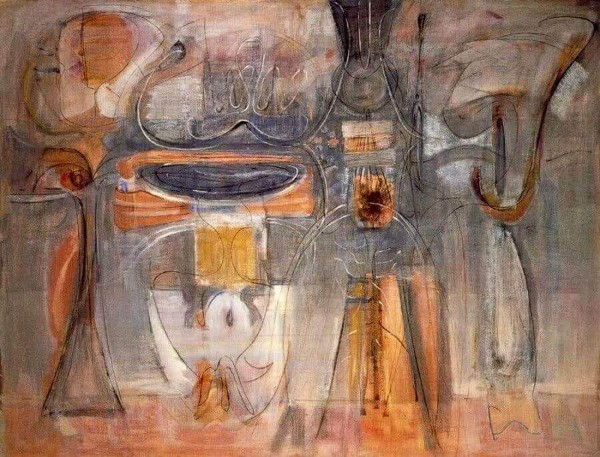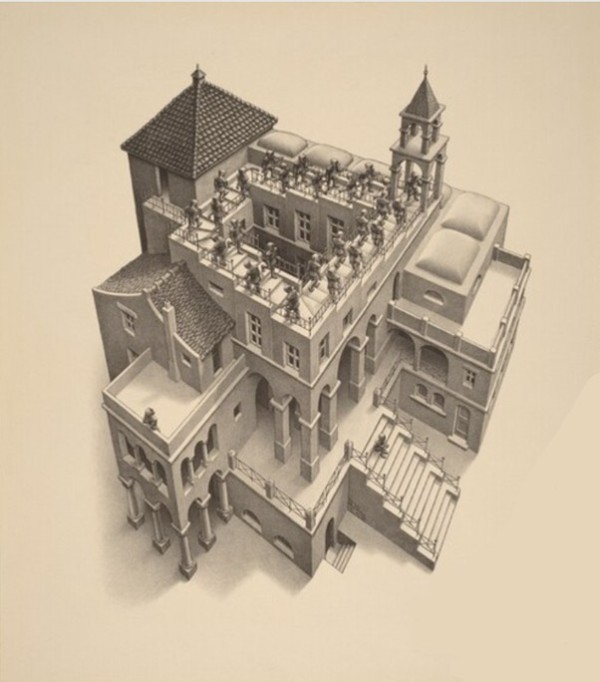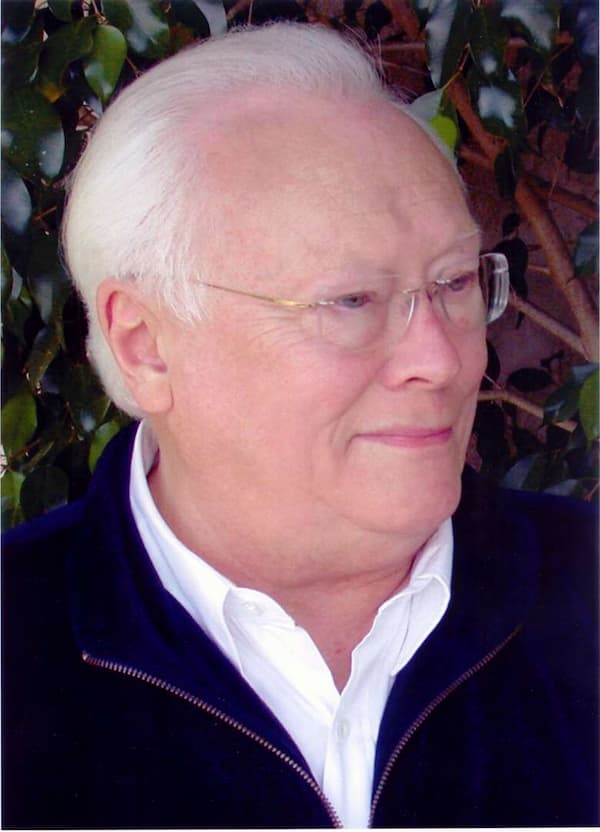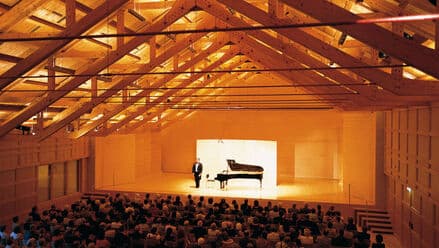Inspirations Behind Morton Gould’s Burchfield Gallery
The American artist, Charles E. Burchfield (1893–1967), was a watercolour painter with a unique vision, described as both romantic and fantastic. After graduating from the Cleveland Institute of Art in 1916, he found his career with the H.M. Birge wallpaper company, where he worked from 1921 to 1928 before setting up as an independent artist. His images were of the world around him, and Village Voice writer Jerry Saltz summed him up as ‘the mystic, cryptic painter of transcendental landscapes, trees with telekinetic halos, and haunted houses emanating ectoplasmic auras’.
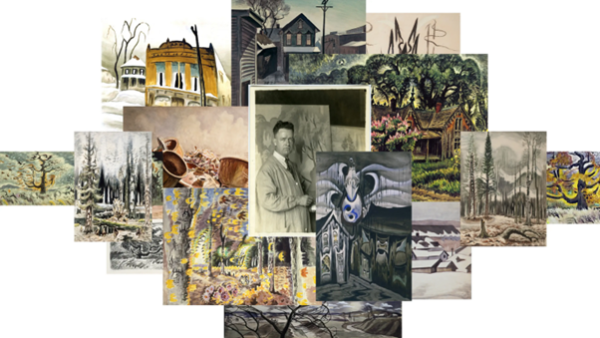
Charles Burchfield surrounded by his art (image by Burchfield Penney Art Center)
Burchfield was a rare 20th-century watercolourist. He worked at an easel, rather than on the flat and fought the perception that watercolours were fragile and impermanent. The majority of his work has been collected in the Burchfield Art Center, originally founded as the Charles Burchfield Center at Buffalo State College. Following a substantial donation of 1,300 works of art collected by Dr. Charles Rand Penney, it is now known as the Burchfield Penney Art Center. Along with the Burchfield collection, it also holds works by western New York artists.
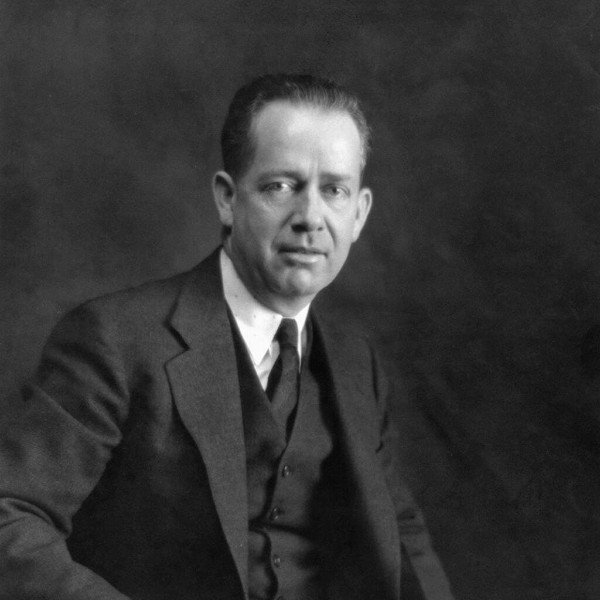
Charles Burchfield
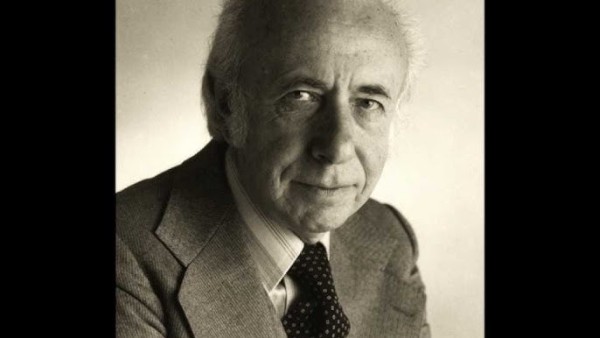
Morton Gould
American composer Morton Gould (1913–1996) was commissioned by the Burchfield Foundation, on a suggestion by Lawrence A. Fleischman of the Kennedy Galleries in New York, for a work commemorating Burchfield. The artist’s nature paintings attracted the composer, particularly ones based on the seasons. The artist referred to specific musical influences as being important to him, and Sibelius was a particular favourite. The work was completed on 6 September 1979.
Gould started in music as a child prodigy, known for his skills in improvisation and composition. He studied at the Institute of Musical Art in New York and, as a teenager, played piano in music theatres, also working with vaudeville acts. He was really on the cusp of the new musical changes coming in: he wrote music for Broadway and for the new art of City Ballet. His gift for melting musical genres seamlessly was unmatched and made so much of his music widely known and likeable. He had a sense of humour as well, composing Hosedown for a fire department and a Tap Dance Concerto for dancer and orchestra. He was awarded the Kennedy Center Honor in 1994 and a posthumous Grammy® Lifetime Achievement Award in 2005.
In his commemoration of Burchfield, or ‘paean’ as he calls it, Gould says that his ‘musical celebration is intended to evoke what Burchfield’s paintings are about, with their vibrant lights and shadows, and constant motion and dancing rhythms’.
He opens with a Prologue in the form of a passacaglia on Burchfield’s initials: C–E–B. Over this are the variants and motifs that will generate the next movements.
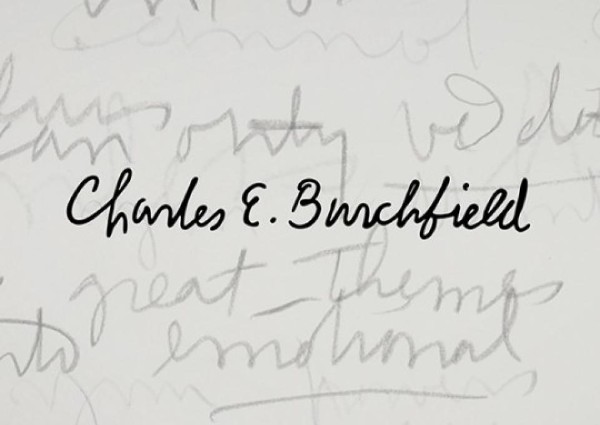
Charles E. Burchfield signature

C–E–B signature
Morton Gould: Burchfield Gallery – I. Prologue (Passacaglia) (Buffalo Philharmonic Orchestra; JoAnn Falletta, cond.)
Gould’s Gallery is based around the idea of the four seasons, which will form the final movement. His first movement is a ballad for Spring.
Morton Gould: Burchfield Gallery – II. Spring (Ballad) (Passacaglia) (Buffalo Philharmonic Orchestra; JoAnn Falletta, cond.)
In Burchfield’s work, the season of Spring is represented in over 40 works, with titles such as March Wind (a.k.a. The March Wind Lighting the Fires of Spring), March Thaw, Spring Rain in the Woods, and the luminous Spring Sky (1915).
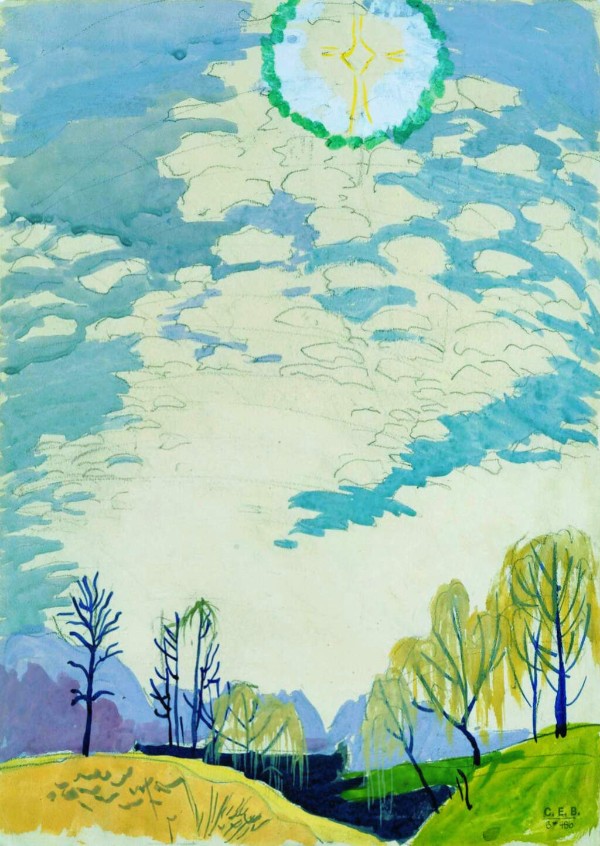
Burchfield: Spring Sky, 1915 (Burchfield Penney Art Center)
And the later Glory of Spring (Radiant Spring) (1950), which makes the forest into something more resembling a cathedral.
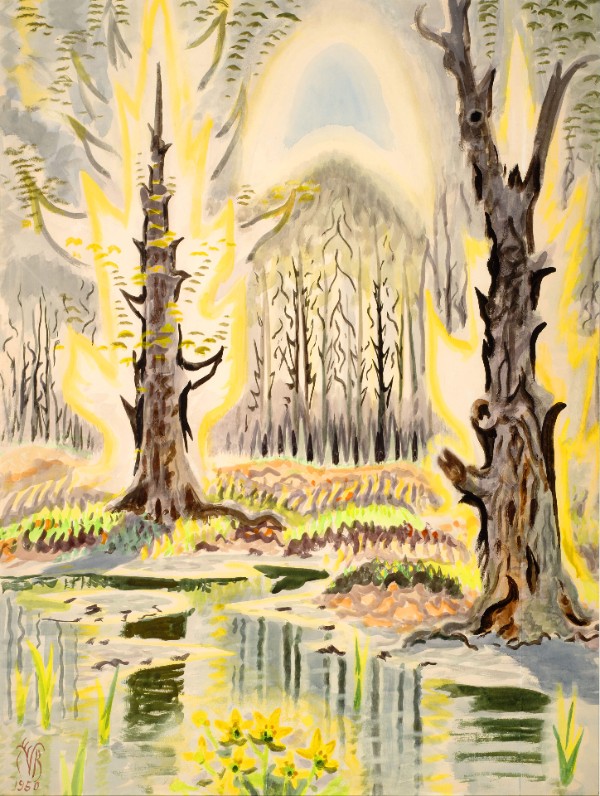
Burchfield: Glory of Spring (Radiant Spring), 1950 (Burchfield Penney Art Center)
Burchfield saw the emergence of Spring as a victory in its battle with Winter. A snow scene such as Fires of Spring in Big Woods carries the coming season in the colours pulsating around the denuded trees.
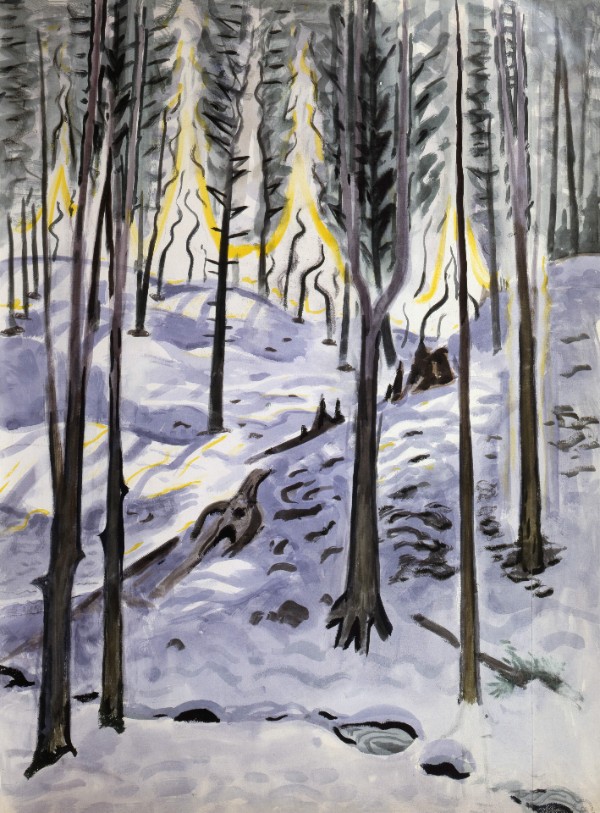
Burchfield: Fires of Spring in Big Woods, 1951 (Burchfield Penney Art Center)
‘Big Woods’ was Burchfield’s name for a site in the Zoar Valley, by Gowanda, New York, where most of his forest and wood pictures were made.
Burchfield’s image entitled Brookside Music from 1950 shows a river flowing while the wind builds up and tosses the reeds and trees around.
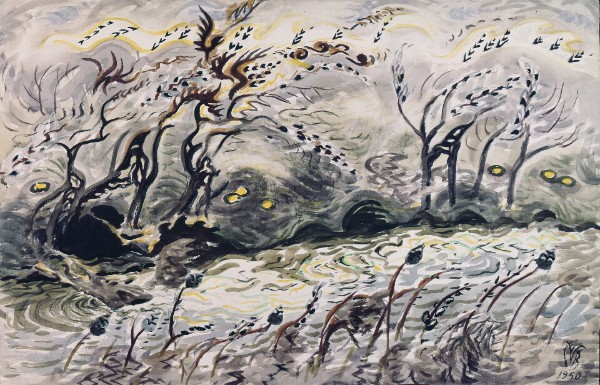
Burchfield: Brookside Music, 1950 (Burchfield Penney Art Center)
In his music, Gould catches the leaves floating on the breeze and gradually builds up the forces. The water’s ripples are there, as are the dancing winds.
Morton Gould: Burchfield Gallery – III. Brookside Music (Interlude) (Buffalo Philharmonic Orchestra; JoAnn Falletta, cond.)
Summer, in Burchfield’s world, is one of green trees and summer rainstorms.
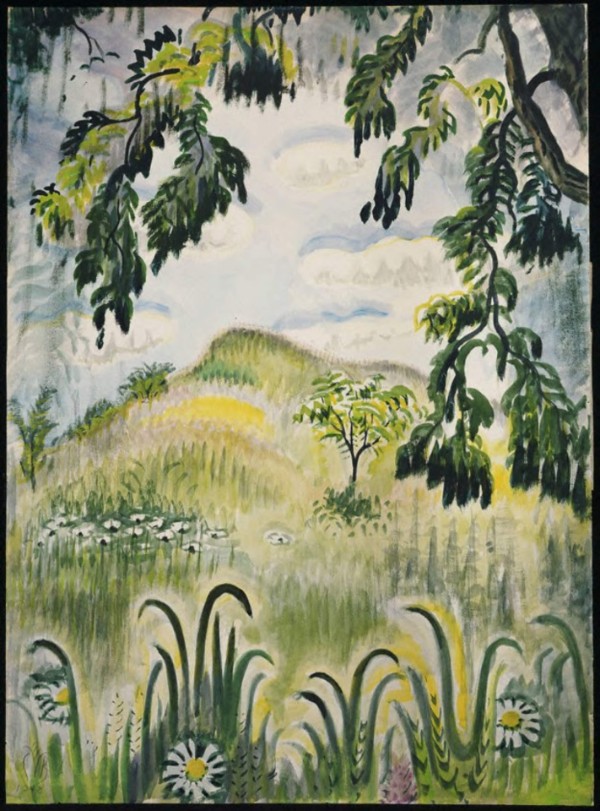
Burchfield: Summer Benediction, 1948 (Burchfield Penney Art Center)
In an entry in his journal from 1962, Burchfield commemorates the first day of summer: ‘The first day of summer – and a perfect day for it – warm, but with cool shade; a northerly breeze. Clear skies, except for pale phantom-like thunderheads seemingly hundreds of miles to the south and southeast …’.
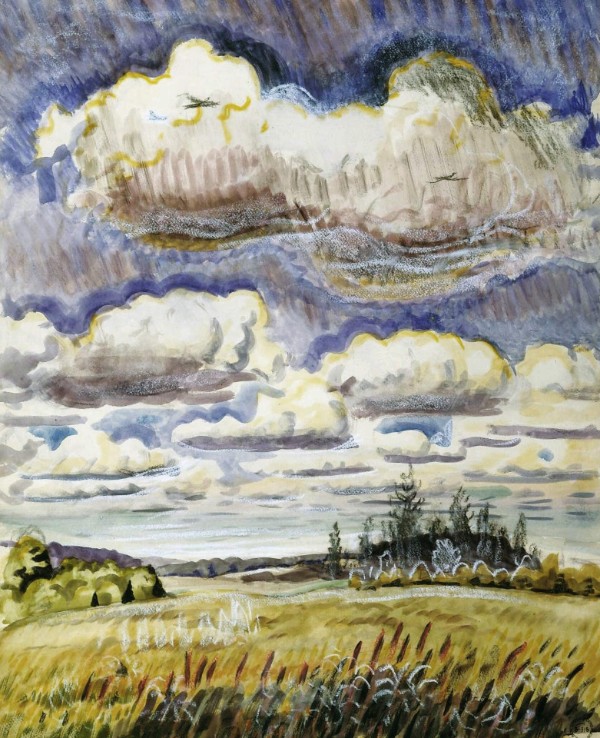
Burchfield: Summer Sky with Clouds, 1946 (Burchfield Penney Art Center)
Gould’s Summer is a serenade, sleepy and shadowy under the trees. There’s a rumble of thunder, but it’s not a worry, just part of the summer sound. The world is hot and humid, shimmering and pulsating in the heat of the sun.
Morton Gould: Burchfield Gallery – IV. Summer (Serenade) (Buffalo Philharmonic Orchestra; JoAnn Falletta, cond.)
Autumn is the time of colour, as the trees yield their summer greenery to the ephemeral colours that will so quickly fall off the trees.
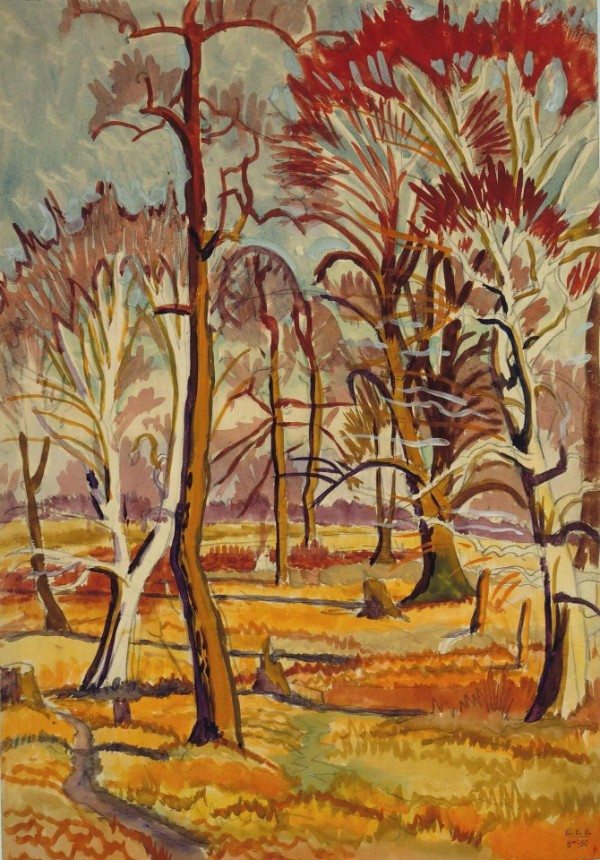
Burchfield: Trees in Autumn, n.d. (Burchfield Penney Art Center)
In an image that brings his Spring paintings to mind, we see the forest where the leaves have fallen at the foot of their trees, leaving bare branches to reach into the air and grasp the last of the warm sunlight. In a journal entry from 1915, he notes, ‘Yesterday morning while on my way to school in the rain, I marked that the colour of autumn seems to have come all at once – walking under the trees I felt as if the color made sound…’.
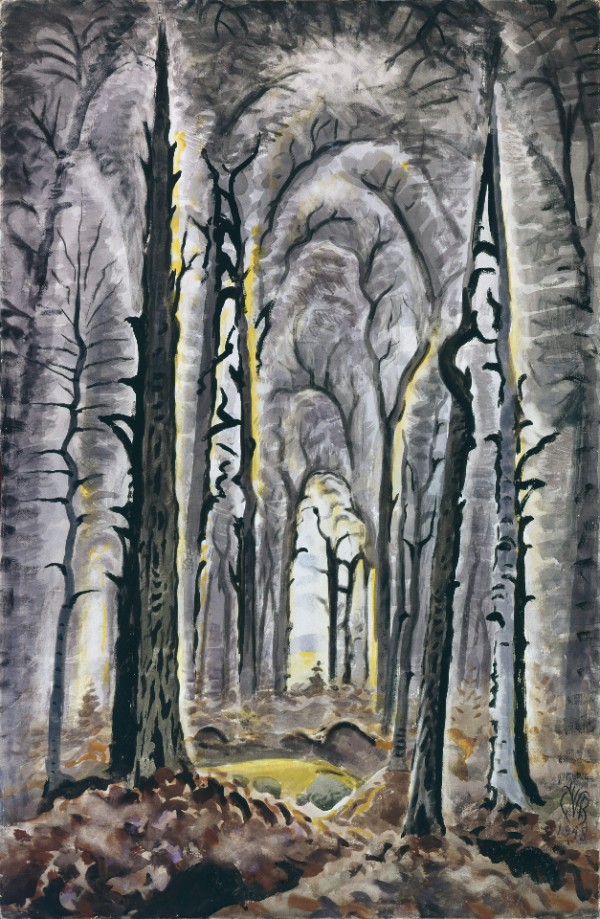
Burchfield: Autumn Sunlight Filtering into the Woods, 1949 (Burchfield Penney Art Center)
In the scherzo movement, the leaves float down, and the skies darken as the sun withdraws its favours. As the leaves descend to the earth, the bare branches reach ever upward in a web of black fingers. It all fades away at the end to the sound of rustling, whispering leaves.
Morton Gould: Burchfield Gallery – V. Autumn (Scherzo) (Buffalo Philharmonic Orchestra; JoAnn Falletta, cond.)
Winter is a time for cold and silence; the sun burns in the sky but provides little beyond shadows.
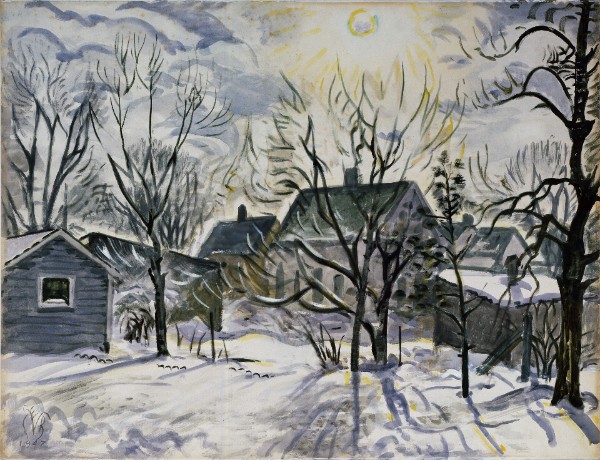
Burchfield: Winter Sun and Backyards (Burchfield Penney Art Center)
The imminent arrival of Spring, however, shows light driving the darkness away, the snow retreating, and blue-sky optimism on its way. The wind has come, and one of Burchfield’s goals was to capture the moment of the changing of the seasons. By bringing together two dissimilar themes and combining them in one painting by reducing them to abstract motifs, he started to achieve his ideal.
He painted this image in Big Woods and described the process:
You may recall last year at the end of March, the big snowstorm we had, and then the glorious thaw that followed— At nearly the end of it I went out painting to a woods on the Gowanda‑Zoar Valley Rd. which I call the Big Woods (where I have painted most of my wood interiors). All at once, everything seemed to crystallise, and I said, “I’m going to paint the ‘Winter to Spring Transition’ today.” Hardly had I set up my easel when a thunderstorm came up. I decided nothing was going to stop my painting, and hurriedly got my huge beach umbrella and my raincoat. I protected my legs with a portfolio (the wind holding it in place). And so, I painted with my nose almost on the paper with thunder crashing, boughs breaking, and rain falling in torrents— A glorious few hours when I seemed to become part of the elements. When I was done in late afternoon, the picture was complete— It seemed as if it had materialised under its own power—
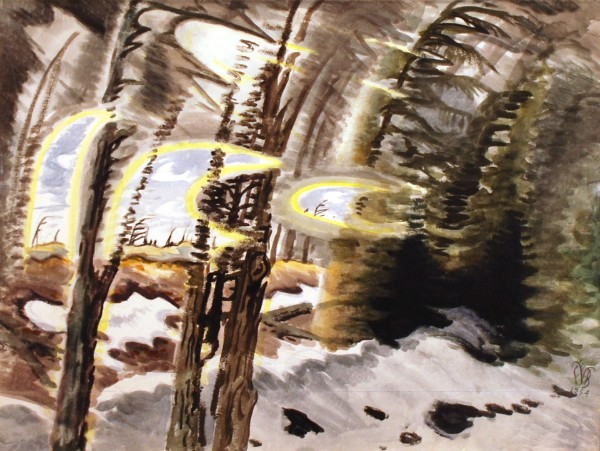
Burchfield: Oncoming Spring, 1954 (Burchfield Penney Art Center)
Gould’s music is dark and melancholic, a melody poking out here and there amidst the shadows. There’s a core stillness, as though one were thinking back on the previous seasons. Other sounds emerge, dripping ice or is that a bird call?
Morton Gould: Burchfield Gallery – VI. Winter (Reverie) (Buffalo Philharmonic Orchestra; JoAnn Falletta, cond.)
In Four Seasons, Burchfield has put us back in the Big Wood, with its cathedral-like vistas. We have snow on the ground and green grass, blue skies and stormy clouds, birds on the wing flying through rays of bright sunshine. At the centre back, trees are glowing with autumn leaves while the evergreens in the foreground hold the colours of spring.

Burchfield: The Four Seasons, 1949–1960 (Krannert Art Museum and Kinkead Pavilion, University of Illinois, Urbana-Champaign)
The final movement is a musical collage, taking Burchfield’s Gothic image and adding in the sound of storms, chorales, and a return of the opening Passacaglia. It’s a pastoral scene, but with all the elements of each season taking part.
Morton Gould: Burchfield Gallery – VII. The Four Seasons (Fantasy) (Buffalo Philharmonic Orchestra; JoAnn Falletta, cond.)
Gould says that the title, Burchfield Gallery, makes a double reference, one to Burchfield’s literal gallery of art and another that places it alongside Gould’s other gallery pieces: Stephen Foster Gallery, Vivaldi Gallery, Rhythm Gallery, and Dance Gallery.
In 1964, Burchfield wrote in his journal that his ideal museum would be one that was circular so that his season paintings could be shown in their proper line, with places for the transitional paintings. This was achieved by the Burchfield Penney Art Center in an exhibition that opened in 2008: Burchfield’s Seasons. This has now become a permanent changing exhibition in the Burchfield Rotunda.
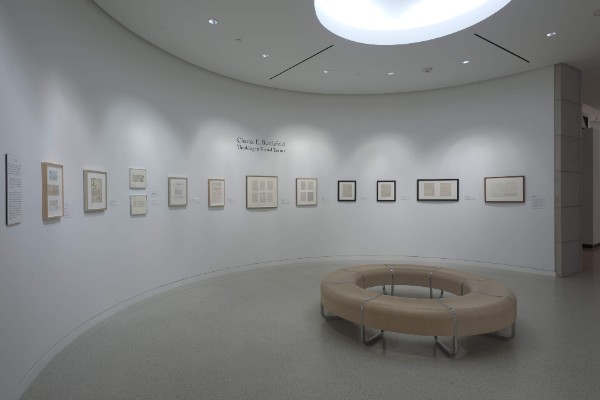
Burchfield Rotunda
The Art Center’s exhibition Musical Burchfields (Feb 2004–June 2004) looked at the significance of both natural sound and music in the artist’s work. In his work, Burchfield ‘strove to achieve the same heroic romanticism that he heard in music, particularly that of Beethoven and Sibelius’. The opening of the Exhibition included a performance of Gould’s Burchfield Gallery and Sibelius’ Second Symphony by the Buffalo Philharmonic Orchestra led by JoAnn Falletta.
As a watercolourist, Burchfield fell out of the action of the art world. There are elements of abstraction, but no cubism and no expressionism. His paintings all have subjects and most of them are landscapes. Few, if any, people appear in his cathedrals of nature. His style is closer to the late impressionists or Fauvists than anything more modern. However, he has an ability to present in his images an optimism for life, for nature, and for the possibilities of the future.
For more of the best in classical music, sign up for our E-Newsletter

